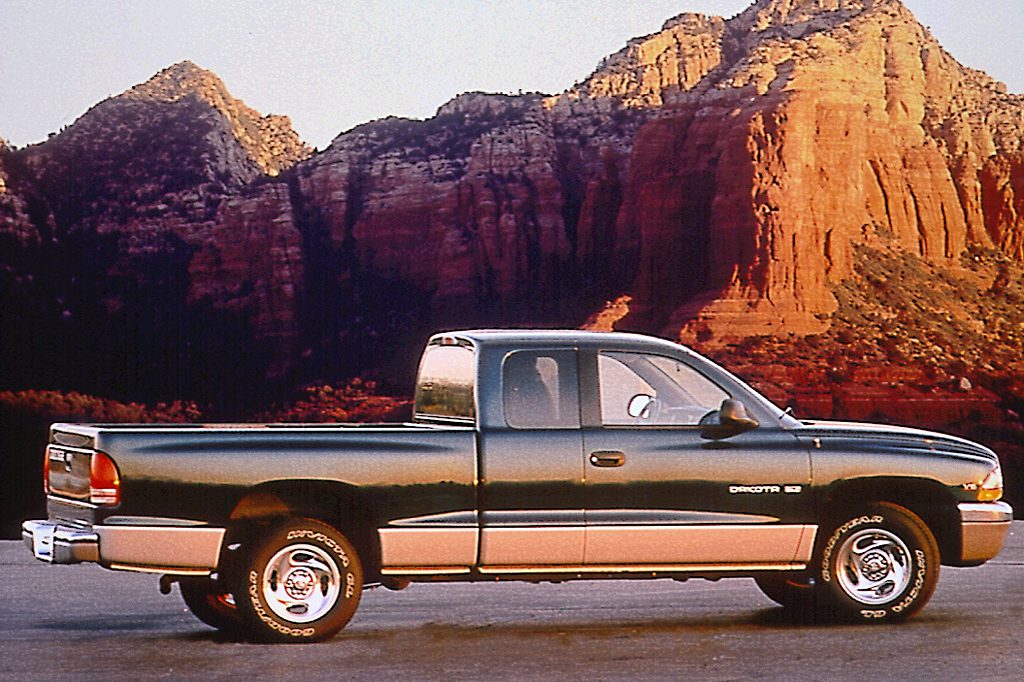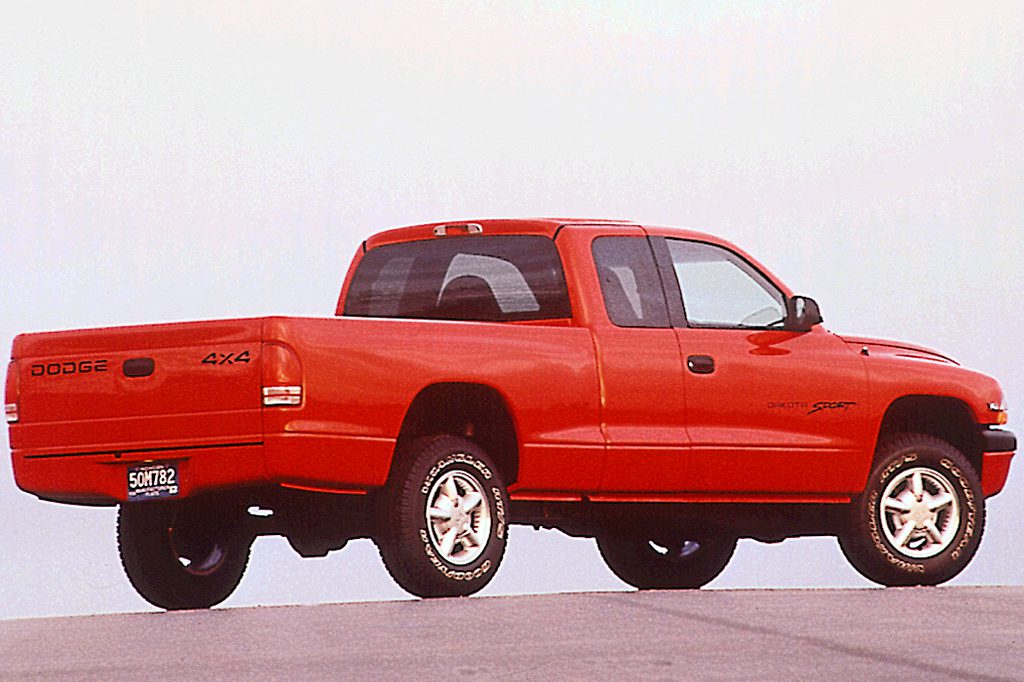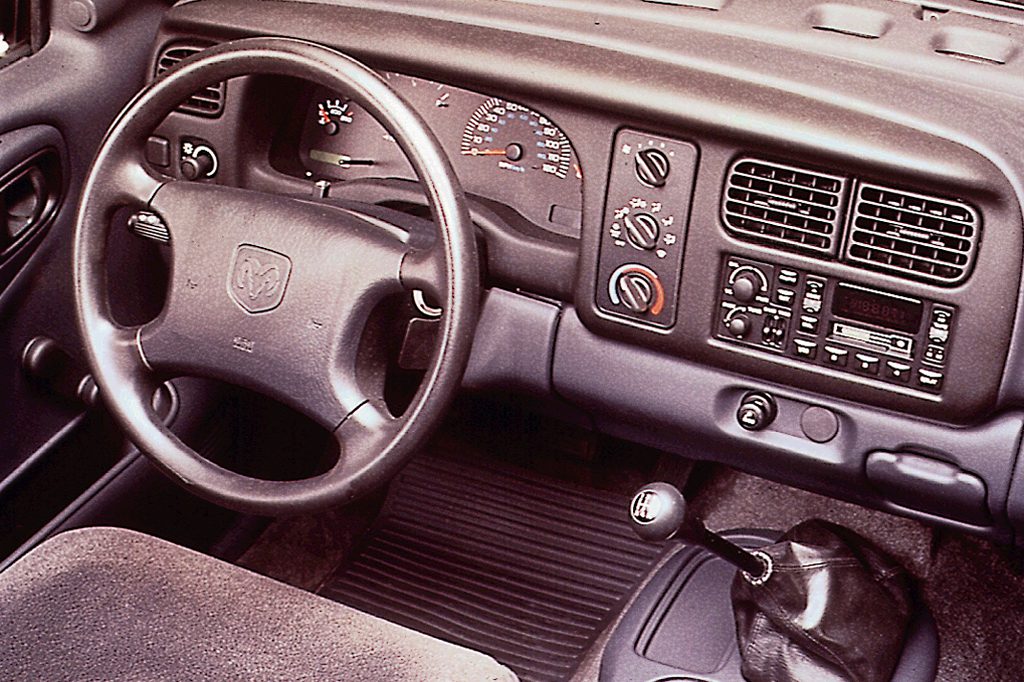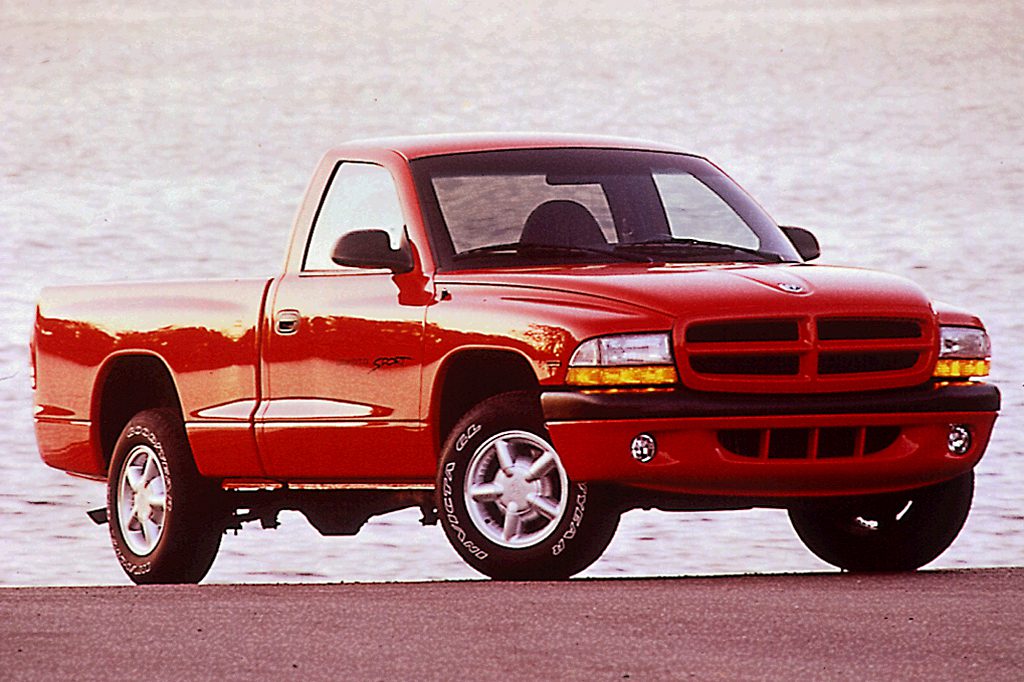| Optional Equipment |
| Option Note: |
| Major Packages |
| Option |
Avail. |
Retail |
Dealer |
| Quick Order Sport Pkg. |
2WD regular cab |
$1635 |
$1439 |
| Mfr. Disc. |
|
985 |
867 |
| Quick Order Sport Pkg. |
4WD regular cab |
1815 |
1597 |
| Mfr. Disc. |
|
1165 |
1025 |
| Quick Order Sport Pkg. |
2WD Club Cab |
980 |
862 |
| Mfr. Disc. |
|
0 |
0 |
| Quick Order Sport Pkg. |
4WD Club Cab |
1145 |
1008 |
| Mfr. Disc. |
|
0 |
0 |
| Cloth 40/20/40 split bench seat (regular cab), carpeting (regular cab), Sport Group (color-keyed grille, front and rear color-keyed fascia, Sport badging, alloy wheels), 215/75R15 white-letter tires (2WD), 235/75R15 white-letter tires (4WD). |
| AGU Sport Plus Pkg. |
2WD regular cab |
1460 |
1285 |
| Mfr. Disc. |
|
1175 |
1034 |
| AGU Sport Plus Pkg. |
4WD regular cab |
1495 |
1316 |
| Mfr. Disc. |
|
1210 |
1065 |
| AGU Sport Plus Pkg. |
2WD Club Cab |
1495 |
1316 |
| Mfr. Disc. |
|
1145 |
1008 |
| AGU Sport Plus Pkg. |
4WD Club Cab |
1505 |
1324 |
| Mfr. Disc. |
|
1155 |
1016 |
| Mfr. Disc. |
w/4.7-liter engine |
915 |
805 |
| AGU Sport Plus Pkg. |
2WD Quad Cab |
1340 |
1179 |
| Mfr. Disc. |
|
990 |
871 |
| Mfr. Disc. |
w/5.9-liter engine |
925 |
814 |
| AGU Sport Plus Pkg. |
4WD Quad Cab |
1350 |
1188 |
| Mfr. Disc. |
|
1000 |
880 |
| Air conditioning, Light Group (mini overhead console, map lights, glove box and courtesy lights, cargo box and underhood lights, auxiliary power outlet), fog lights, rear stabilizer bar, 255/65R16 white-letter tires (2WD), 265/70R16 all-terrain white-letter tires (4WD). Regular cab and Club Cab require Sport Pkg., 3.9-liter or 4.7-liter engine. NA with R/T Pkg. |
| ACM Motorsports Special Edition Group |
2WD regular cab |
835 |
735 |
| Mfr. Disc. |
|
585 |
515 |
| ACM Motorsports Special Edition Group |
2WD Club Cab |
825 |
726 |
| Mfr. Disc. |
|
575 |
506 |
| ACM Motorsports Special Edition Group |
2WD Quad Cab |
980 |
862 |
| Mfr. Disc. |
|
730 |
642 |
| ACM Motorsports Special Edition Group |
2WD w/Sport Plus Group |
550 |
484 |
| Color-keyed bumpers, bright grille, badging, rear stabilizer bar (Club Cab, Quad Cab), 255/65R16 yellow-letter tires, special alloy wheels. Requires Sport Pkg., Light Group, fog lights. |
| Quick Order SLT Pkg. |
2WD regular cab |
3010 |
2930 |
| Mfr. Disc. |
|
2340 |
2059 |
| Quick Order SLT Pkg. |
4WD regular cab |
3190 |
2807 |
| Mfr. Disc. |
|
2520 |
2217 |
| Quick Order SLT Pkg. |
2WD Club Cab |
2325 |
2046 |
| Mfr. Disc. |
|
1095 |
964 |
| Quick Order SLT Pkg. |
4WD Club Cab |
2505 |
2204 |
| Mfr. Disc. |
|
1275 |
1122 |
| Air conditioning, tilt steering wheel, cruise control, cloth 40/20/40 split bench seat (regular cab), carpeting (regular cab), front floormats, SLT Decor Group (heavy-duty sound insulation, chrome bumpers, bright grille, alloy wheels), Light Group (mini overhead console, glovebox and courtesy lights, cargo box and underhood lights, auxiliary power outlet), 215/75R15 white-letter tires (2WD), 235/75R15 white-letter tires (4WD). Requires optional engine. |
| Quick Order SLT Pkg. |
Quad Cab |
1220 |
1074 |
| Mfr. Disc. |
2WD Quad Cab |
955 |
841 |
| Mfr. Disc. |
4WD Quad Cab |
1120 |
986 |
| Air conditioning, tilt steering wheel, cruise control, floormats, hood insulation, chrome bumpers and grille. |
| ATK SLT Plus Pkg. |
2WD regular cab |
1105 |
972 |
| Mfr. Disc. |
|
655 |
576 |
| ATK SLT Plus Pkg. |
2WD Club Cab |
1130 |
994 |
| Mfr. Disc. |
|
680 |
598 |
| ATK SLT Plus Pkg. |
4WD regular cab/Club Cab |
1140 |
1003 |
| Mfr. Disc. |
|
890 |
783 |
| Mfr. Disc. |
w/4.7-liter engine |
550 |
484 |
| ATK SLT Plus Pkg. |
2WD Quad Cab |
1305 |
1148 |
| Mfr. Disc. |
|
855 |
752 |
| Mfr. Disc. |
w/5.9-liter engine |
790 |
695 |
| ATK SLT Plus Pkg. |
4WD Quad Cab |
1315 |
1157 |
| Mfr. Disc. |
|
1065 |
937 |
| Power mirrors, power windows, power door locks, remote keyless entry, rear stabilizer bar, 255/65R16 white-letter tires (2WD), 265/70R16 all-terrain white-letter tires (4WD). Requires SLT Pkg. |
| R/T Pkg. |
2WD regular cab |
2380 |
2094 |
| R/T Pkg. |
2WD Club Cab |
2420 |
2130 |
| Includes limited-slip differential, lowered sport suspension, cloth high back bucket seats, leather-wrapped tilt steering wheel, cruise control, Light Group, heavy-duty sound insulation, fog lights, color-keyed bumpers, wheel flares, 255/55R17 tires. Requires Quick Order Sport Pkg., 5.9-liter V8 engine, 4-speed automatic transmission. |
| AJK Deluxe Convenience Group |
|
390 |
343 |
| Cruise control, tilt steering column. NA 2.5-liter engine. |
| AJP Power Convenience Group |
regular cab, Club Cab |
710 |
625 |
| AJP Power Convenience Group |
Quad Cab |
885 |
779 |
| Power mirrors, power windows and door locks, remote keyless entry. Requires Quick Order Pkg. |
| AJL Power Overhead Convenience Group |
regular cab/Club Cab w/SLT Pkg. or Sport Plus Pkg. or R/T Pkg. |
985 |
867 |
| AJL Power Overhead Convenience Group |
regular cab/Club Cab w/Sport Pkg. |
1015 |
893 |
| AJL Power Overhead Convenience Group |
Quad Cab |
1160 |
1021 |
| AJL Power Overhead Convenience Group |
ordered w/SLT Plus Pkg. |
275 |
242 |
| Power Convenience Group plus overhead console w/storage, universal garage door opener, trip computer, compass, outside temperature indicator, automatic day/night rearview mirror. |
| ADA Light Group |
regular cab |
145 |
128 |
| ADA Light Group |
Club Cab |
155 |
136 |
| Mini overhead console, glovebox and courtesy lights, map lights, cargo box and underhood lights, auxiliary power outlet. Std. Quad Cab. |
| 2100 GVWR |
2WD regular cab |
310 |
273 |
| 2100 GVWR |
2WD W/Quick Order Pkg. |
185 |
163 |
| 2000 GVWR |
2WD Club Cab |
310 |
273 |
| 2000 GVWR |
2WD Club Cab w/Quick Order Pkg. |
185 |
163 |
| 2000 GVWR |
4WD regular cab |
360 |
317 |
| 2000 GVWR |
4WD regular cab w/Quick Order Pkg. |
55 |
48 |
| 1800 GVWR |
4WD Club Cab w/Quick Order Pkg. |
40 |
35 |
| Requires 3.9-liter engine, limited-slip differential. |
| Trailer Tow Group |
4WD regular cab, Club Cab, Quad Cab |
275 |
242 |
| Class IV trailer-hitch receiver, 7-wire trailer harness, 4-wire adapter. Requires Heavy Duty Service Group. |
| Powertrain |
| Option |
Avail. |
Retail |
Dealer |
| 2.5-liter 4-cylinder engine |
2WD Club Cab |
0 |
0 |
| Mfr. Disc. |
(credit) |
-200 |
-176 |
| 3.9-liter V6 engine |
2WD regular cab/Club Cab |
560 |
493 |
| 4.7-liter V8 engine |
4WD regular cab/Club Cab, Quad Cab |
590 |
519 |
| 4.7-liter V8 engine |
2WD regular cab/Club Cab |
1150 |
1012 |
| Mfr. Disc. |
2WD Club Cab |
590 |
519 |
| Regular cab and Club Cab require Quick Order Pkg. |
| 5.9-liter V8 engine |
2WD regular cab/Club Cab |
1685 |
1483 |
| 5.9-liter V8 engine |
2WD Quad Cab |
1190 |
1047 |
| 5.9-liter V8 engine |
4WD Quad Cab |
1125 |
990 |
| Requires 4-speed automatic transmission. Regular cab and Club require Quick Order Sport Pkg. and R/T Pkg. |
| 5-speed manual transmission |
|
0 |
0 |
| Mfr. Disc. |
2WD regular cab/Club Cab (credit) |
-200 |
-176 |
| Requires 2.5-liter engine. |
| 4-speed automatic transmission |
|
975 |
837 |
| NA w/2.5-liter engine, 4.7-liter engine. |
| Multi-speed automatic transmission |
|
975 |
837 |
| Requires 4.7-liter engine. |
| Optional axle ratio |
|
40 |
35 |
| Limited-slip differential |
|
285 |
251 |
| 2WD requires optional axle ratio when ordered with V8 engine. 4WD requires optional axle ratio ordered with standard V6 engine. |
| Full-time transfer case |
4WD |
395 |
348 |
| Requires automatic transmission, 4.7-liter or 5.9-liter engine. Regular cab, Club Cab require Sport Pkg. or SLT Pkg. |
| Safety |
| Option |
Avail. |
Retail |
Dealer |
| Front and rear antilock brakes |
|
495 |
436 |
| Comfort & Convenience Features |
| Option |
Avail. |
Retail |
Dealer |
| Air conditioning |
|
800 |
704 |
| Leather Interior Group |
Quad Cab |
580 |
510 |
| Includes leather upholstery, front bucket seats, center console. Requires Sport Plus Group or SLT Plus Group, Power Convenience Group, power driver seat, optional radio. |
| 6-way power driver seat |
Club Cab, Quad Cab |
320 |
282 |
| Club Cab requires Sport Pkg. or SLT Pkg. |
| Cloth bench seat |
regular cab |
55 |
48 |
| Cloth bucket seats |
|
210 |
185 |
| Includes center console. Requires Quick Order Pkg. |
| Rear defogger |
Club Cab, Quad Cab |
230 |
202 |
| Includes heated mirrors. Requires Power Convenience Group or Power Overhead Convenience Group or SLT Plus Pkg. |
| Heated power mirrors |
|
20 |
18 |
| Regular cab and Club Cab require Power Convenience Group or Power Overhead Convenience Group or SLT Plus Group. Quad Cab requires Power Convenience Group. |
| AM/FM/cassette w/equalizer |
|
300 |
264 |
| Includes Infinity sound system, CD changer controls. Regular cab and Club Cab require Quick Order Pkg. |
| AM/FM/CD player w/equalizer |
|
480 |
422 |
| Includes Infinity sound system, CD changer controls. Regular cab and Club Cab require Quick Order Pkg. |
| AM/FM/cassette/CD player w/equalizer |
|
660 |
581 |
| Includes Infinity sound system, CD changer controls. Regular cab and Club Cab require Quick Order Pkg. |
| Steering-wheel radio controls |
|
75 |
66 |
| Requires Power Convenience Group, leather-wrapped steering wheel, AM/FM/cassette/CD player. |
| Tilt steering wheel |
2WD regular cab/Club Cab |
140 |
123 |
| Leather-wrapped steering wheel |
|
50 |
44 |
| Requires Deluxe Convenience Group. |
| Front floormats |
regular cab, Club Cab |
30 |
26 |
| Requires Sport or SLT Pkg. |
| Front and rear floormats |
Quad Cab |
50 |
44 |
| Appearance and Miscellaneous |
| Option |
Avail. |
Retail |
Dealer |
| Theft-deterrent system w/alarm |
|
225 |
198 |
| Requires Power Convenience Group. |
| Bodyside moldings |
regular cab, Club Cab |
75 |
66 |
| Requires SLT or SLT Plus Pkg. |
| Fog lights |
|
120 |
106 |
| Regular cab and Club Cab require Quick Order Pkg. |
| Sliding rear window |
|
115 |
101 |
| NA w/rear defogger. |
| Bed liner |
|
245 |
165 |
| Engine-block heater |
|
35 |
31 |
| Two-tone paint |
|
195 |
172 |
| Special Purpose, Wheels and Tires |
| Option |
Avail. |
Retail |
Dealer |
| Heavy-Duty Service Group |
ordered w/manual transmission or 5.9-liter engine |
120 |
106 |
| Heavy-Duty Service Group |
ordered w/automatic transmission |
180 |
158 |
| Includes heavy-duty engine cooling, transmission oil cooling, power steering fluid cooling, heavy-duty battery and alternator. |
| Heavy-duty engine cooling |
ordered w/automatic transmission |
120 |
106 |
| Heavy-duty engine cooling |
ordered w/manual transmission |
60 |
53 |
| Skid plate group |
4WD |
130 |
114 |
| Tire and Handling Pkg. |
2WD regular cab |
395 |
348 |
| Tire and Handling Pkg. |
2WD Club Cab/Quad Cab |
420 |
370 |
| Tire and Handling Pkg. |
4WD |
430 |
378 |
| Tire and Handling Pkg. |
2WD Quad Cab w/5.9-liter engine |
355 |
312 |
| Rear stabilizer bar, 255/65R16 white-letter tires (2WD), 265/70R16 all-terrain white-letter tires. Regular cab and Club Cab require Quick Order Pkg. NA with 2.5-liter engine. |
| 235/75R15 tires |
regular cab, Club Cab |
190 |
167 |
| 235/75R15 tires |
regular cab/Club Cab w/Quick Order Pkg., Quad Cab |
65 |
57 |





